【三】实战:SpringBoot与ElasticSearch完美融合,WebFlux响应式编程实现
【其三】使用Filebeat解析你的SpringBoot日志到Elasticsearch
1. 前言
这是最后一部分,内容是使用Filebeat解析你的SpringBoot日志到Elasticsearch,并且能在Kibana上对你产生的日志进行分析。
前两节内容的部分你可以在如下地址找到:
可能你会有疑问,为什么不使用logstash呢?
确实Filebeat和Logstash都是Elastic Stack中用于收集、解析和发送日志数据的工具,但是对于个人开发者来说,Filebeat比Logstash轻量级很多,而且配置也简单不少,只要一个yml配置即可指定日志文件,然后docker容器一拉起来就完成了。日志数据分析什么的,其实现在还没有这么多精力去折腾,需求只是把不同服务器的日志同步到一个ES中,这样可以方便在Kibana上一次性看到不同服务器不同应用和API的日志,而不用一个个ssh连接上去,cd到指定目录,等待less命令滚动好一会儿才到最新的日志。
2. Filebeat介绍
首先放一下Filebeat的官方文档,这是大多数信息的来源。Filebeat Reference
Filebeat是一个轻量级、高效的工具,Filebeat的主要目标是从各种数据源(如日志文件、系统日志、应用程序输出等)收集日志数据,并将其传输到Elasticsearch或Logstash等目标存储或处理系统。
是的Filebeat也可以搭配logstash使用,所以后续有升级再安排logstash也不迟。
3. Filebeat使用
在使用前,我们要做的第一件事就是,找到日志的位置,如果你是根据前两节博客看过来的,那么在项目**demo-springboot-elasticsearch** 中,log会生成的路径配置logback.xml 中
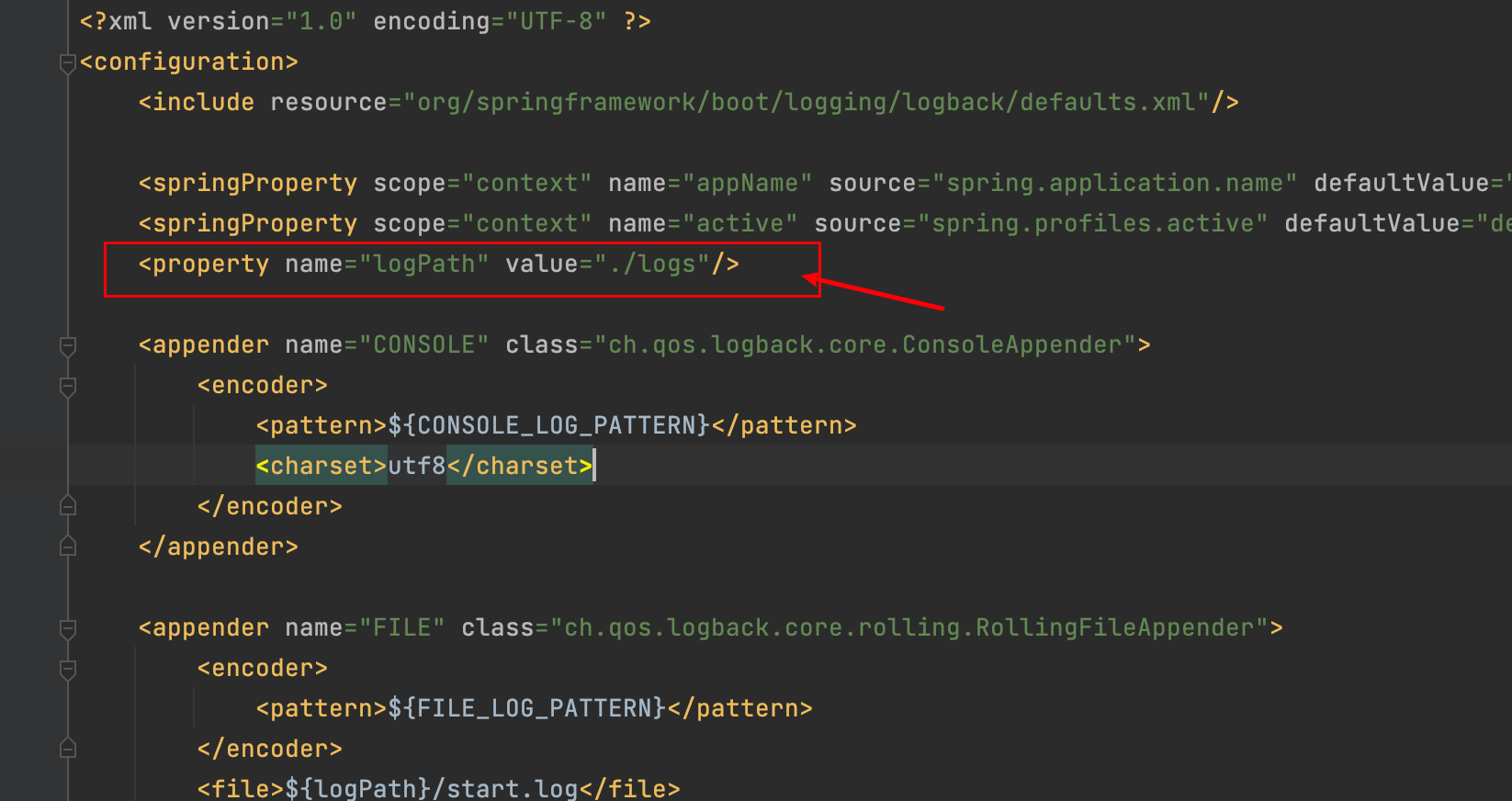
默认是会生成到当前项目的目录下,所以你需要记录一下日�志目录的绝对路径,这个等待会用到。
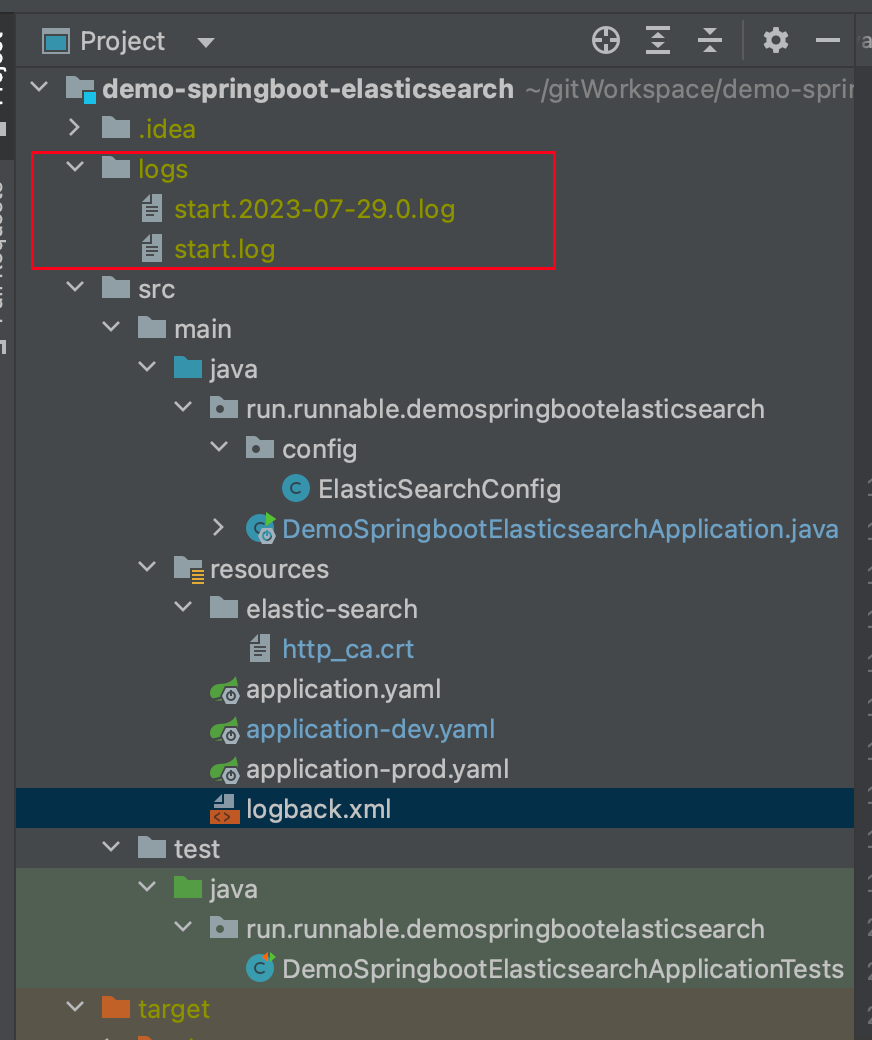
3.1 准备http_ca.crt和filebeat.yml配置文件
知道日志路径了,那么我们可以开始准备安装Filebeat了,这里依然是采取docker 部署的方案。
http_ca.crt 不知道你是否还有印象,在新版的ES中,需要通过这个建立SSL连接,这里也是需要的。你可以再从ES容器中复制一个出来,如下命令会把http_ca.crt直接复制到当前目录。
docker cp elasticsearch:/usr/share/elasticsearch/config/certs/http_ca.crt .
接着我们直接下载一个filebeat.yml的模板文件
curl -L -O https://raw.githubusercontent.com/elastic/beats/8.9/deploy/docker/filebeat.docker.yml
下载比较慢的同学可以直接用下面这个内容,也是一样的
filebeat.config:
modules:
path: ${path.config}/modules.d/*.yml
reload.enabled: false
filebeat.autodiscover:
providers:
- type: docker
hints.enabled: true
processors:
- add_cloud_metadata: ~
output.elasticsearch:
hosts: '${ELASTICSEARCH_HOSTS:elasticsearch:9200}'
username: '${ELASTICSEARCH_USERNAME:}'
password: '${ELASTICSEARCH_PASSWORD:}'
然后我们对这个模板文件改改,改成根据你的环境改成如下样子:
#这个不用变,这个是filebeat内置了一些模块可以帮我们解析日志,比如nginx之类的,
#这里我们springboot日志不通过这个解析
filebeat.config:
modules:
path: ${path.config}/modules.d/*.yml
reload.enabled: false
#日志文件输入到filebeat的来源
filebeat.inputs:
- type: filestream
enabled: true
id: demo-springboot-elasticsearch
paths:
- /share/Develop/dockerData/runnable-run/demo-springboot-elasticsearch/logs/*.log
pipeline: springboot_pipeline
tags: ["demo-springboot-elasticsearch"]
processors:
- add_cloud_metadata: ~
#filebeat输出的配置,是你的ES配置
output.elasticsearch:
hosts: ['https://ip:9200']
username: 'elastic'
password: 'password'
ssl:
enabled: true
#http_ca.crt
certificate_authorities: "/usr/share/filebeat/http_ca.crt"
setup.kibana:
host: "ip:5601"
username: "elastic"
password: "password"
indices:
- index: "demo-springboot-elasticsearch"
when.contains:
tags: "demo-springboot-elasticsearch"
上面一些配置的说明:
type: filestream这个类型有挺多,不够在这里我们需要让filebeat读取的是.log文件,所以使用filestream即可id: demo-springboot-elasticsearch:指定一个唯一的ID,用于标识这个输入配置。paths:指定要监控的日志文件的路径。/share/Develop/dockerData/runnable-run/demo-springboot-elasticsearch/logs/*.log:这里使用通配符*匹配指定目录下所有以.log为后缀的日志文件。Filebeat将监控这些文件中的日志数据。
pipeline: springboot_pipeline这个说的是日志推送到ES之后,需要ES用哪个pipeline解析日志,等等我们会说到这个。tags: ["demo-springboot-elasticsearch"]为从这个输入源收集的所有日志事件添加一个标签(tag)。这个标签可以帮助您在后续的处理中识别特定的日志数据来源。output.elasticsearch:这部分指定了Filebeat将日志数据发送到Elasticsearch的配置。hosts: ['https://ip:9200']:指定Elasticsearch集群的主机地址和端口。在这里使用https协议进行安全连接。username: 'elastic':连接Elasticsearch时使用的用户名。password: 'password':连接Elasticsearch时使用的密码。ssl.enabled: true:启用SSL/TLS安全连接,确保数据传输的安全性。certificate_authorities: "/usr/share/filebeat/http_ca.crt":指定CA证书文件的路径,用于验证与Elasticsearch之间的连接。这个等等证书我们要通过docker挂载进去,所以路径可以不变setup.kibana:这部分用于配置Filebeat与Kibana之间的连接。host: "ip:5601":指定Kibana的主机地址和端口。username: "elastic":连接Kibana时使用的用户名。password: "password":连接Kibana时使用的密码。indices:这部分指定了将日志数据写入Elasticsearch时的索引配置。index: "demo-springboot-elasticsearch":指定索引名称为"demo-springboot-elasticsearch",Filebeat将会将收集到的日志数据写入该索引。when.contains:这里是一个条件判断,表示当日志事件包含特定标签"demo-springboot-elasticsearch"时,将其写入到上述指定的索引中。
filebeat有大佬已经整理好了挺多的模板,可以看这篇博客:filebeat自定义索引名,filebeat索引模板
当你配置好后,别着急,还没到启动容器那一步,先去Kibana配置一下刚刚filebeat.yml文件中的springboot_pipeline ,这个springboot_pipeline 是告诉ES要怎么解析你的日志,总不能把日志丢上去,啥也不管吧。
3.2 创建pipeline解析SpringBoot日志
登录Kibana,我们可以先去Dev Tools中写一下解析SpringBoot日志的语法。
当然这部分你可以直接跳过,用之前我已经写好的,这部分内容是告诉你如果日志推送了ES,但是在ES没有找到对应的索引,或者索引没有数据那么需要通过这样的方式排查你的pipeline解析是否有问题。
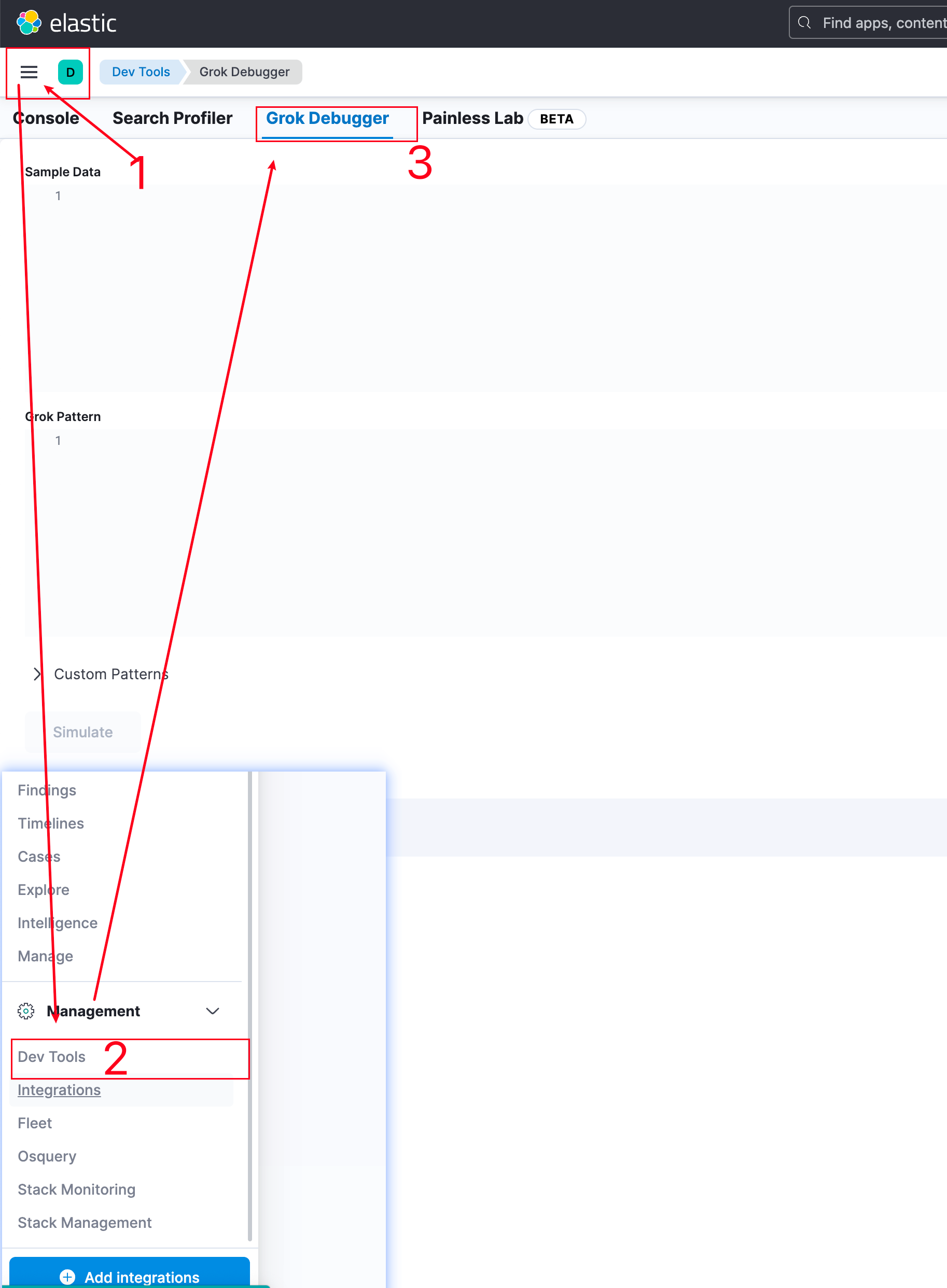
在Sample Data中填一些SpringBoot日志样本,我知道有些同学用的日志格式是自定义的
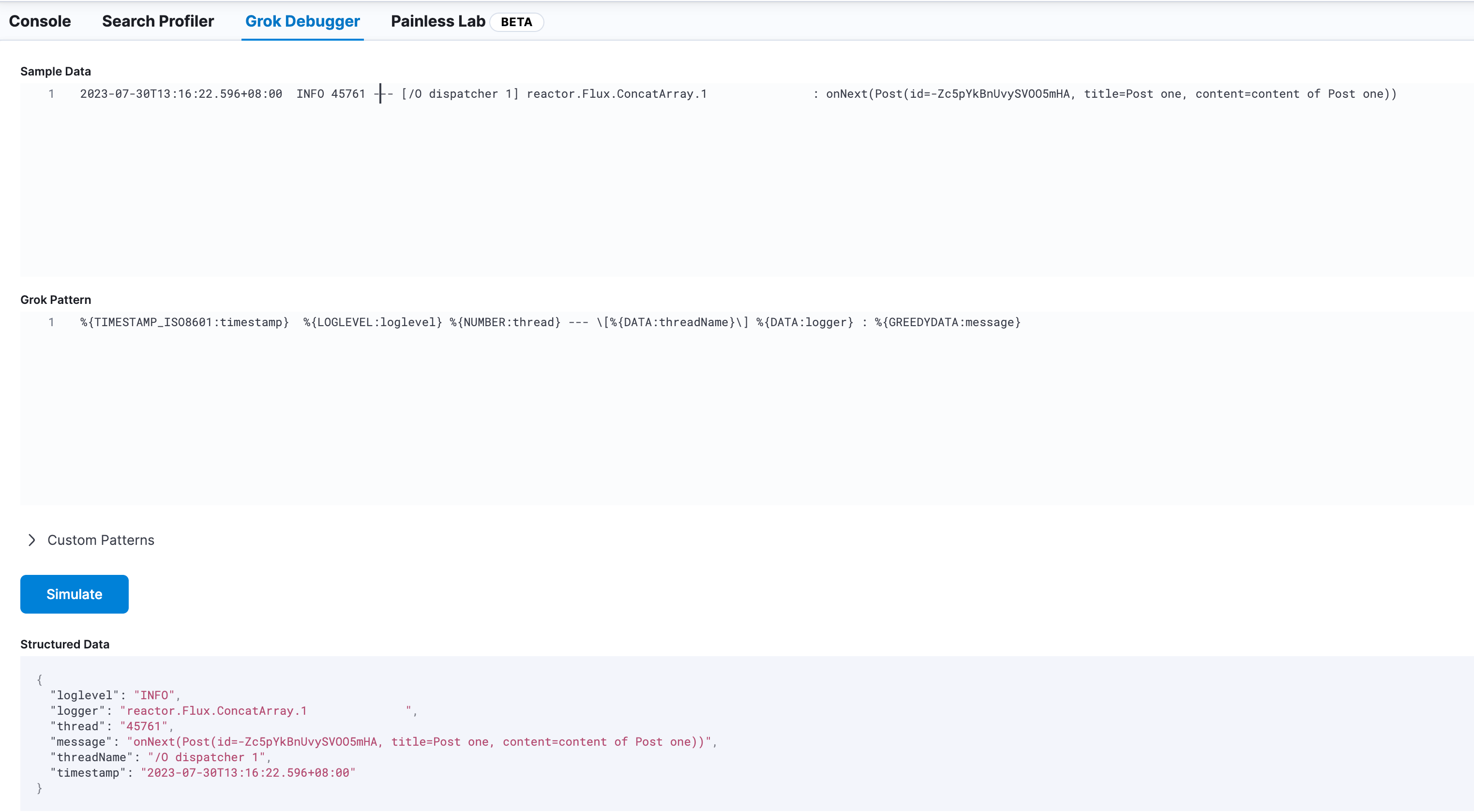
然后在下方的Grok Pattern中写匹配语法,ES有个页面是用来说这个 Grok Pattern怎么玩的,你能在这里找到:https://www.elastic.co/guide/en/logstash/current/plugins-filters-grok.html
如下是我使用的:
%{TIMESTAMP_ISO8601:timestamp} %{LOGLEVEL:loglevel} %{NUMBER:thread} --- \[%{DATA:threadName}\] %{DATA:logger} : %{GREEDYDATA:message}
%{TIMESTAMP_ISO8601:timestamp} %用来表示一个解析的表达式,TIMESTAMP_ISO8601表示匹配规则,timestamp表示之后生成的字段名字。
然后点击下面的Simulate ,正确匹配上的话,那么就会显示解析出来的字段,如果有问题那么会在页面右下角提示报错的。
接着回到Console页面,用你能匹配日志的Grok Pattern替换patterns,可能需要增加\ 转义符
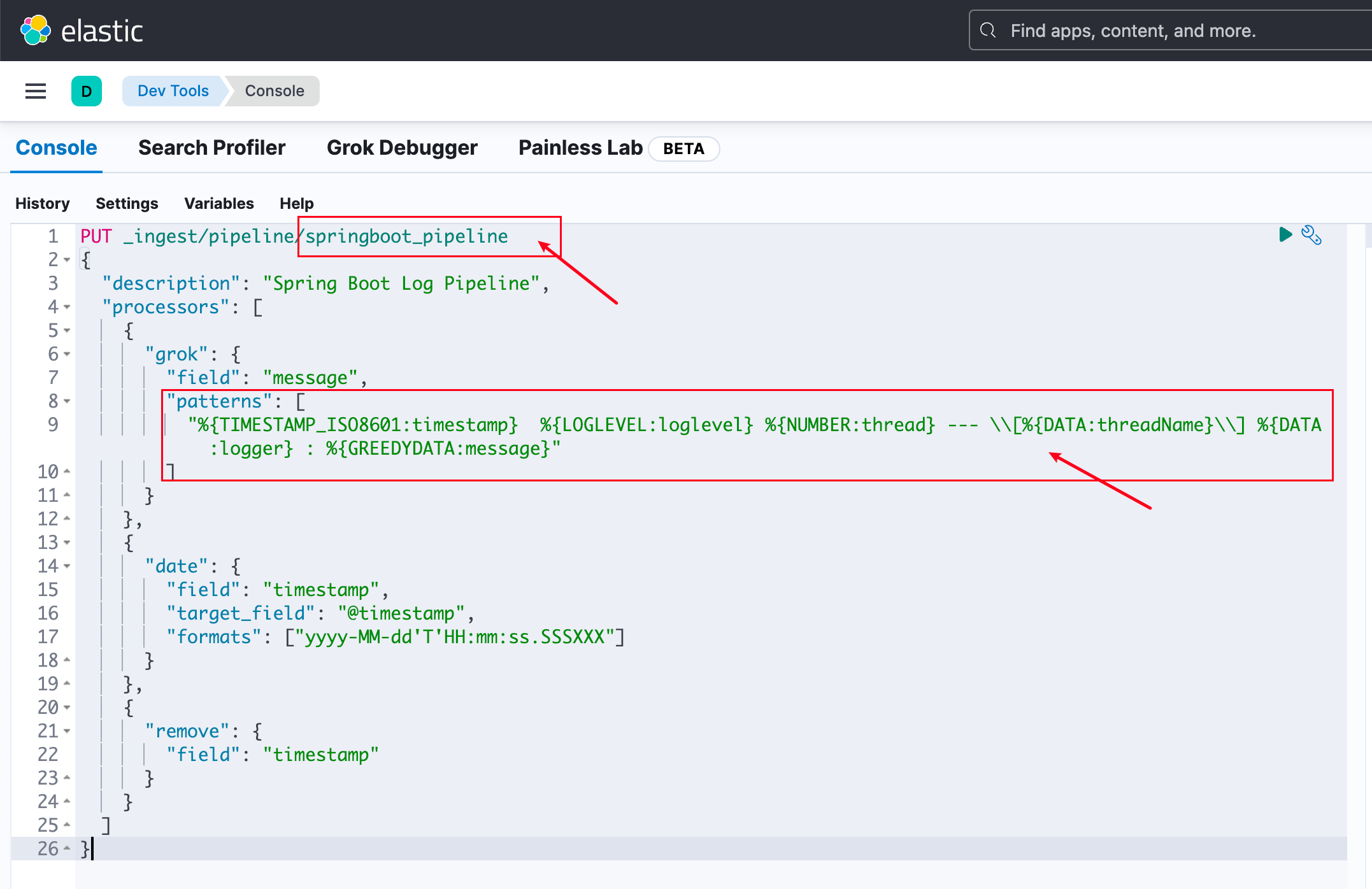
使用如下代码把springboot_pipeline写入ES,然后点一下右上角的运行按钮就行
PUT _ingest/pipeline/springboot_pipeline
{
"description": "Spring Boot Log Pipeline",
"processors": [
{
"grok": {
"field": "message",
"patterns": [
"%{TIMESTAMP_ISO8601:timestamp} %{LOGLEVEL:loglevel} %{NUMBER:thread} --- \\[%{DATA:threadName}\\] %{DATA:logger} : %{GREEDYDATA:message}"
]
}
},
{
"date": {
"field": "timestamp",
"target_field": "@timestamp",
"formats": ["yyyy-MM-dd'T'HH:mm:ss.SSSXXX"]
}
},
{
"remove": {
"field": "timestamp"
}
}
]
}
上面的这个命令你需要注意的是formats,如果时间格式对不上,会导致ES解析不了。
此时你的ES就有了这个pipeline,现在就剩下最后一步,运行filebeat容器了
2023-11-04 17:57:04 更新
有了这个pipeline之后,如果还想直接验证一下怎么做呢,可以直接使用如下命令,在刚刚那个窗口再进行执行,如果有错误的话ES会直接抛出来。
POST _ingest/pipeline/ping_server/_simulate
{
"docs": [
{
"_source": {
"title": "Introducing cloud computering",
"tags": "openstack,k8s",
"message": "2023-11-04 16:04:14 - 64 bytes from 192.168.193.22: icmp_seq=2 ttl=64 time=49.839 ms "
}
}
]
}
正常执行时,如下:

3.3 docker启动filebeat
回到你的服务器终端,进入到放filebeat.yml 和http_ca.crt 目录,创建一个data目录用来放置filebeat的数据,否则容器删除新建会导致日志全部被重新推到ES,要是一年的数据重新推会想哭的。。。
mkdir data
这里我是放在同一个文件夹下,接着使用如下命令启动,你需要修改/share/Develop/dockerData/runnable-run/ 为你日志所在路径
docker run \
--name=filebeat \
--user=root \
--volume="$(pwd)/filebeat.yml:/usr/share/filebeat/filebeat.yml:ro" \
--volume="$(pwd)/http_ca.crt:/usr/share/filebeat/http_ca.crt:ro" \
--volume="$(pwd)/data/:/usr/share/filebeat/data/" \
--volume="/share/Develop/dockerData/runnable-run/:/share/Develop/dockerData/runnable-run/:ro" \
--volume="/var/lib/docker/containers:/var/lib/docker/containers:ro" \
--volume="/var/run/docker.sock:/var/run/docker.sock:ro" \
docker.elastic.co/beats/filebeat:8.8.0 filebeat -e --strict.perms=false
-user=root:以root用户身份运行容器,确保Filebeat有足够的权限来访问所需的资源和文件。-volume="$(pwd)/filebeat.yml:/usr/share/filebeat/filebeat.yml:ro":将主机当前目录下的filebeat.yml配置文件挂载到容器中的/usr/share/filebeat/filebeat.yml位置,并以只读模式(ro)挂载。--volume="$(pwd)/data/:/usr/share/filebeat/data/"挂载filebeat的数据目录-volume="$(pwd)/http_ca.crt:/usr/share/filebeat/http_ca.crt:ro":将主机当前目录下的http_ca.crt证书文件挂载到容器中的/usr/share/filebeat/http_ca.crt位置,并以只读模式(ro)挂载。-volume="/share/Develop/dockerData/runnable-run/:/share/Develop/dockerData/runnable-run/:ro":将主机上的/share/Develop/dockerData/runnable-run/目录挂载到容器中的/share/Develop/dockerData/runnable-run/位置,并以只读模式(ro)挂载。-volume="/var/lib/docker/containers:/var/lib/docker/containers:ro":将主机上的/var/lib/docker/containers目录挂载到容器中的/var/lib/docker/containers位置,并以只读模式(ro)挂载。-volume="/var/run/docker.sock:/var/run/docker.sock:ro":将主机上的Docker守护进程的Unix域套接字挂载到容器中的/var/run/docker.sock位置,并以只读模式(ro)挂载。这是为了Filebeat能够与Docker守护进程通信,以获取Docker容器信息和日志。docker.elastic.co/beats/filebeat:8.8.0:指定要运行的Filebeat容器的镜像名称和版本号。filebeat -e --strict.perms=false:运行Filebeat容器时的命令,其中:filebeat:表示执行Filebeat程序。e:以调试模式运行Filebeat,将日志输出到控制台。-strict.perms=false:禁用对配置文件权限的严格检查,这是为了兼容一些特定的容器环境,确保Filebeat能够读取配置文件和其他文件。
这里我没有设置-d是为了方便第一次启动的时候,你可以看到日志有真的被filebeat读取,并且推送到ES。
如果一切正常,那么你能看到日志输出有SpringBoot的日志内容,并且在Kibana上也能看到index被正确创建和有对应的数据,如图:

4. 异常处理
如果发现filebeat启动,但是没有推送日志到ES,以下是你需要检查的地方:
- 日志目录是否挂载正确到filebeat
- filebeat.yaml文件配置
springboot_pipeline是否正确解析
也使用Del Tools直接测试你的grok pattern是否正确
5. 扩展部分
完成上述内容之后,其实意味着什么日志你都能丢给ES进行解析,只要是有格式输出的日志,直接自己写Grok Pattern。
所以服务器上其他容器能输出日志的,和之前写的API生成日志全丢上去,然后好玩的来了,在ES的dashborder中,创建对应属性的统计不就是一个简单的监控大屏了嘛,比如nginx的日志放上去就直接能知道博客的ip请求统计。
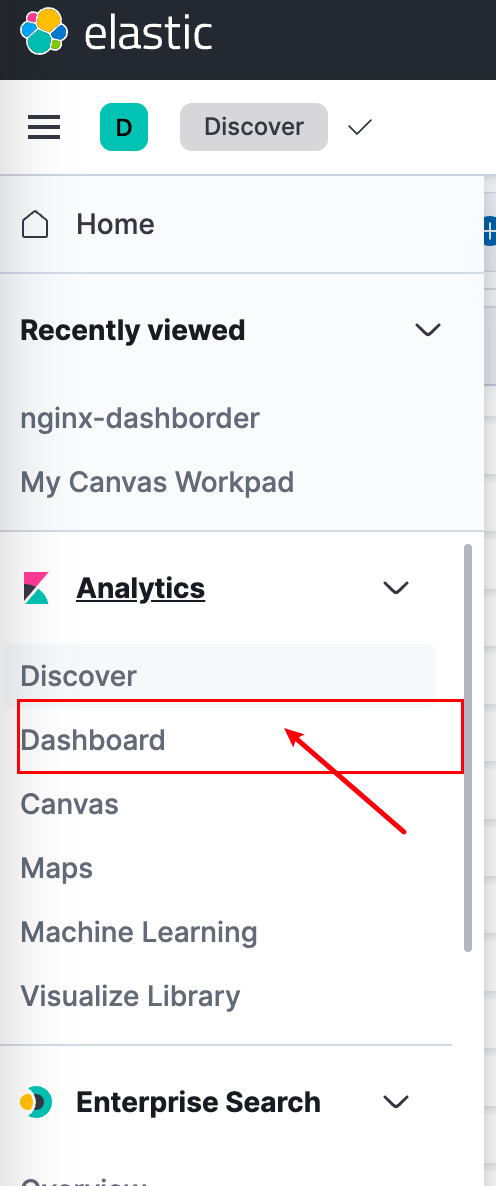
这部分内容就需要你自己探索一下怎么玩了
比如我把nginx日志丢上去就发现近一个月,访问我博客最多的竟然有长沙地区的,而且安卓设备也不少。

参考内容
Metricbeat : Certificate signed by unknow authority
input logs an error when an existing input is reloaded with the same ID
Parsing logback log files with filebeat and sending them to Elasticsearch